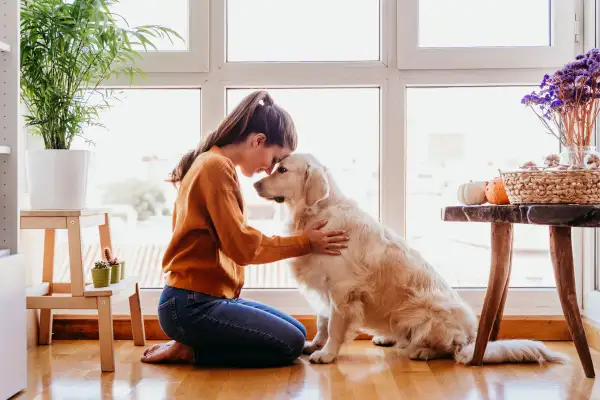Pet-Safe Homes 101: Essential Security Features Every Pet Parent Needs to Know

Pets aren't just animals; they're beloved members of the family, and there are certain safety considerations to keep in mind when we bring a four-legged friend home.
Read on for a list of essential security features to implement in your household so that your pet can thrive and explore its new environment risk-free.
Pet cameras
You can monitor your pet remotely by installing a pet camera. These devices often come equipped with useful features like live video streaming, two-way audio communication and motion detection. The cameras in the best home security systems also double up as pet cameras, so you're covered if you invest in a home security setup.
With these devices, you can ensure your pet is safe and comfortable, and react in a timely manner if a problem comes up or if they gain access to a room they're not supposed to be in. A pet camera can also capture any concerning behaviors or activities that you may not be aware of, allowing you to address these through training or behavioral modification.
Microchip and I.D. tags
Properly identifying your pet is key to ensuring its safety if it escapes or gets lost. Fit your dog or cat with a secure collar and ID tag that includes your name and one or two phone numbers.
Consider a microchip, too. This device is about the size of a grain of rice, and it is implanted under the pet's skin using a needle. This microchip contains identification numbers that can be picked up by a scanner. These identification numbers lead to a database that stores your contact information so you can be notified if your pet is found.
That said, microchipping doesn't replace the need for ID tags. Whoever finds a lost pet must have a scanner on hand to retrieve the microchip information, and these devices aren't all that common. But if they take the lost pet to a veterinary clinic or shelter, the staff is likely to have a scanner.
Legible ID tags combined with a microchip are a multi-layered approach and increase the chances of reuniting with your companion animal if it gets lost or escapes.
Lockable cabinets
Secure cabinets keep pets away from hazards like toxic food and cleaning supplies. The trick is to look for child-proofing products, as these solutions typically overlap with security solutions marketed to pet owners. Of course, if you own a particularly strong and large breed, it's best to look for products that can withstand their strength.
Renters and homeowners can upgrade existing kitchen and bathroom cabinets with a variety of latches: spring-loaded cabinet locks, magnetic cabinet locks, and U-shaped locks that slide around the cabinet handles and keep the doors locked in place.
Hazardous items such as cleaning supplies, medications and chemicals are best stored in these areas. Or alternatively, in high shelves where pets can't reach. The same applies to food items, especially if your pet is inclined to overeating or rummaging the kitchen for snacks
Baby gates
Baby gates are an excellent solution for sealing off areas of the house and keeping your pet secure.
Look for gates appropriate for the animal's height and jumping ability. Large dogs like Great Danes may easily jump over most gates, and you'll likely need another solution to block their path.
Another tip is to buy a gate with more than one locking mechanism. Savvy pets can often figure out how to open a gate, and you'll be thankful to have a second or third way to keep it closed.
Window and door screens
An open window is a dangerous invitation for cats. A bird or a loud noise can lure your cat off the ledge, whether you live on the ground level or the sixth floor. This type of incident is so common among domestic cats that vets call it "high-rise syndrome."
Keeping the windows closed is the easiest solution, but it isn't always feasible, and come summer, you'll appreciate letting the breeze in.
You can install a rental-friendly mesh guard on your windows to keep your cats secure while allowing fresh air to circulate. Another option is to install child-proofing tools that open the window to a desired width (two inches is typically enough to keep small animals from slipping through).
Pet emergency preparedness kit
You'll need a plan to care for your pet after emergencies like wildfires, tornadoes, earthquakes or flood warnings. A basic pet disaster kit should include the following:
- Your pet's vaccination documents and I.D. tags
- Bowls, food and water for at least three days
- Manual can opener
- Medications and medical records
- Current photos of your pet in case you get separated
- Leash and collar
- Secure pet carrier for transport
- Pet first aid kit
- Litter box, doggy pads and any other sanitation supply your pet needs
Store this kit in an accessible location in your home, next to the emergency kits for the rest of the household members.
Temperature control
Extreme temperatures can pose a danger to pets, especially during hot summers and severe winter conditions. The most pet-friendly housing is properly insulated and equipped with heating and cooling systems that maintain a comfortable environment for your pets year-round. Avoid leaving your pets unattended inside a vehicle or outside without any access to shade or shelter, as it can expose them to life-threatening temperatures.
According to the Animal Welfare Act, dogs shouldn't be housed in temperatures higher than 85 degrees for more than four hours. Additional ventilation (fans or air conditioning) is crucial if the temperature rises past that number at any point during the day. During winter, the Humane Society recommends keeping pets sheltered at all times. If your pet spends a lot of time outdoors, make sure they have enough food to offset the energy spent staying warm and place their water in a plastic bowl (their tongues can stick to frozen metal).
Secured trash cans
Lid-locking trash cans will keep curious pets out of the bin and away from hazards like food scraps, bones and plastic items. Another alternative is to place weights at the bottom of the bin to prevent the dog from knocking the trash can over.
Some pet parents go as far as buying bear-proof trash cans if they own large dogs that are determined to raid the bin.
Tips on how to pet-proof your home
Pet-proof your home by area, examining each section, including the yard, balcony or patio. What hazards are at your pet's eye level, and what items can they easily reach if they stand on their hind legs or jump?
Adjustments depend on the type of pet you care for and its temperament. An older dog may not need as many safety precautions as a puppy, and cat owners must pay special attention to windows, balconies and the washer and dryer.
Kitchen and bathroom
Most pets find trouble in the kitchen and bathroom, as these areas are where we store most cleaning supplies and potential hazards like food and waste.
- Keep human and pet food out of reach and in closed containers
- Stash cleaning supplies and the trash behind closed doors and locked cabinets
- Place medications, cleaners, chemicals and laundry supplies on high shelves
- Keep trash cans covered or inside a latched cabinet
- Check for and seal off any small spaces, nooks or holes inside cabinets and behind appliances where your pet may get trapped
- Keep the toilet lid closed to prevent your pet from drinking any cleaning chemicals or from drowning (especially if they're young)
- Clear countertops and low coffee tables to discourage counter-surfing
Family and living room
- Keep cords and wires from lamps, DVD players, televisions and other appliances organized and out of reach
- Tuck away window blind cords. Pets (especially curious kittens) can get tangled up and hurt themselves
- Put children's toys, games and crafting supplies away in a secure drawer, box or cabinet
- Take stock of which houseplants are pet-safe and which aren't. Store the toxic plants in hard-to-reach areas
- Make sure all heating/air vents have covers
- Check whether candles, diffusers and essential oils are pet-safe
- Keep fragile décor off easy to access surfaces like coffee tables and consoles
Garage and laundry room
- Move all chemicals to high shelves or behind secure doors
- Make sure to clean any antifreeze spills from the floor and driveway, as one taste can be lethal to animals
- Bang on your car hood to ensure that your kitten (or any neighborhood cat) has not hidden in the engine compartment for warmth
- Keep all sharp objects and tools out of reach
- Cats are known for hiding in the dryer and washer. Keep these appliances closed when you're not using them (even if you're walking away for just a moment).
Bedroom
- Store skin care, medications, lotions and makeup in drawers, cabinets or boxes
- Be mindful of where you keep your laundry and make sure that there aren't any leftover snacks or candies in any pockets
- Store clothes, socks and shoes behind closed doors. These items can cause serious intestinal problems if swallowed
- Move electrical and phone wires out of reach of chewing
- Scan your bedroom for areas where your kitten can hide and check drawers and closet doors before closing them
Yard, patio or balcony
The fence or balcony rail in the outdoor parts of your home should be tall enough to prevent your pet from escaping. There should be no gaps or holes where your pet could squeeze through or get stuck.
Consider pet safety when landscaping your yard, too. Herbicides and pesticides can be toxic to dogs and cats and should be avoided unless absolutely necessary. If you must use these chemicals in your yard, read the product instructions thoroughly. The general recommendation is to allow all pesticides, herbicides, and fertilizers to dry fully and keep your pet away from the area for at least two days.
Lastly, buy fertilizers without ingredients like bone and blood, and avoid birdseed mixes that include raisins. Dogs love to eat these ingredients even though they can make them seriously ill.
Pet-friendly plants
Many common household plants are toxic to pets. However, the risk of houseplants depends entirely on your pet's temperament and habits: some dog breeds are habitual chewers and digging up these toxic houseplants can become their favorite pastime. Others are completely uninterested and pose no worry for their owners.
The safest bet is to opt for pet-friendly varieties, especially if you're bringing a new pet home or if your pet's going to be alone for long periods of time. The second best option is to store your houseplants in hard-to-reach places.
Here's a list of some of the most popular pet-friendly houseplants:
- Chinese money plant
- Money tree
- Rattlesnake plant
- Spider plant
- Calathea
- Certain succulents
- Venus flytrap
- Boston fern
- Watermelon peperomia
Check out the Toxic Plant Database from the American Society for the Prevention of Cruelty to Animals (ASPCA) for a complete list.
Pet-Safe Homes 101 FAQs
How to dog-proof a fence
How to keep a dog safe in a car
Summary of Money's Pet-Safe Homes 101
Through careful planning and attention to detail, pet parents can create a secure home for their beloved four-legged family members. Here are the most important safety features to keep in mind:
- Identification: I.D tags with contact information and microchipping
- Pet-proof gates to seal of specific areas of the home
- Lockable trash bins and latched cabinets to store food, medication and cleaning supplies
- Pet emergency kits with everything you need to leave at a moment's notice
- Motion-sensing cameras to keep an eye on your pet throughout the day
- Secure fences without any holes or weak points that your pet can get through
- Window coverings or wedges to keep your cat or dog from falling out
- Pet-friendly plants, fertilizers and lawn treatments


